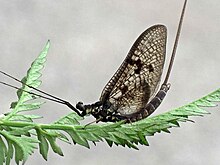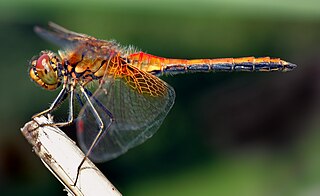
A dragonfly is a flying insect belonging to the infraorder Anisoptera below the order Odonata. About 3,000 extant species of true dragonfly are known. Most are tropical, with fewer species in temperate regions. Loss of wetland habitat threatens dragonfly populations around the world. Adult dragonflies are characterized by a pair of large, multifaceted compound eyes, two pairs of strong, transparent wings, sometimes with coloured patches, and an elongated body. Many dragonflies have brilliant iridescent or metallic colours produced by structural colouration, making them conspicuous in flight. An adult dragonfly's compound eyes have nearly 24,000 ommatidia each.

Damselflies are flying insects of the suborder Zygoptera in the order Odonata. They are similar to dragonflies, which constitute the other odonatan suborder, Anisoptera, but are smaller and have slimmer bodies. Most species fold the wings along the body when at rest, unlike dragonflies which hold the wings flat and away from the body. An ancient group, damselflies have existed since at least the Lower Permian beginning about 299 million years ago, and are found on every continent except Antarctica.

In biology, a nymph is the immature form of some invertebrates, particularly insects, which undergoes gradual metamorphosis (hemimetabolism) before reaching its adult stage. Unlike a typical larva, a nymph's overall form already resembles that of the adult, except for a lack of wings. In addition, while a nymph moults, it never enters a pupal stage. Instead, the final moult results in an adult insect. Nymphs undergo multiple stages of development called instars.

Mayflies are aquatic insects belonging to the order Ephemeroptera. This order is part of an ancient group of insects termed the Palaeoptera, which also contains dragonflies and damselflies. Over 3,000 species of mayfly are known worldwide, grouped into over 400 genera in 42 families.

Aquatic insects or water insects live some portion of their life cycle in the water. They feed in the same ways as other insects. Some diving insects, such as predatory diving beetles, can hunt for food underwater where land-living insects cannot compete.
The most recent understanding of the evolution of insects is based on studies of the following branches of science: molecular biology, insect morphology, paleontology, insect taxonomy, evolution, embryology, bioinformatics and scientific computing. It is estimated that the class of insects originated on Earth about 480 million years ago, in the Ordovician, at about the same time terrestrial plants appeared. Insects may have evolved from a group of crustaceans. The first insects were landbound, but about 400 million years ago in the Devonian period one lineage of insects evolved flight, the first animals to do so. The oldest insect fossil has been proposed to be Rhyniognatha hirsti, estimated to be 400 million years old, but the insect identity of the fossil has been contested. Global climate conditions changed several times during the history of Earth, and along with it the diversity of insects. The Pterygotes underwent a major radiation in the Carboniferous while the Endopterygota underwent another major radiation in the Permian.

Ephemerellidae are known as the spiny crawler mayflies. They are a family of the order Ephemeroptera. There are eight genera consisting of a total 90 species. They are distributed throughout North America as well as the UK. Their habitat is lotic-erosional, they are found in all sizes of flowing streams on different types of substrates where there is reduced flow. They are even found on the shores of lakes and beaches where there is wave action present. They move by swimming and clinging, they are very well camouflaged. Most species have one generation per year. They are mostly collector-gatherers.

Ephemera danica, the green drake or green drake mayfly, is a species of mayfly in the genus Ephemera.

Progomphus borealis is a species of dragonfly in the family Gomphidae. This dragonfly species is commonly known as the gray sanddragon.
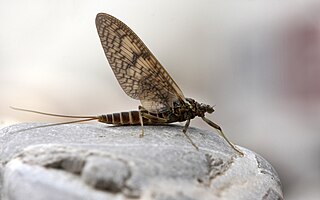
Rhithrogena germanica is a European species of mayfly, and is "probably the most famous of all British mayflies", because of its use in fly fishing. It is known in the British Isles as the March brown mayfly, a name which is used in the United States for a different species, Rhithrogena morrisoni. It emerges as a subimago at the end of winter, and can be distinguished from similar species by a dark spot on the femur of each leg.

Cloeon dipterum is a species of mayfly with a Holarctic distribution. It is the most common mayfly in ponds in the British Isles and the only ovoviviparous mayfly in Europe. Males differ from females in having turbinate eyes.

Coxoplectoptera or "chimera wings" is an extinct order of stem-group mayflies containing one family, Mickoleitiidae.
Behningiidae is a family of mayflies. It is a primitive family; the nymphs burrow in the sediment but lack tusks on their mandibles, and the forelegs are not modified for burrowing. The gills are ventral, and the ones on the first abdominal segment are single and are longer than the gills on the other segments. The forelegs are palp-like and the other two pairs of legs are modified to protect the gills. The family is holarctic in distribution. The genus Dolania occurs in North America and the other three genera occur in northern Europe and Asia.
Dolania is a monotypic genus of mayfly in the family Behningiidae containing the single species Dolania americana. It is found in the southeastern United States, as far south as Florida, and is generally uncommon. The adult insects emerge before dawn in early summer, mate and die within the space of about thirty minutes. The female deposits her eggs in the water and dies within five minutes of emergence, believed to be the shortest adult lifespan of any insect.
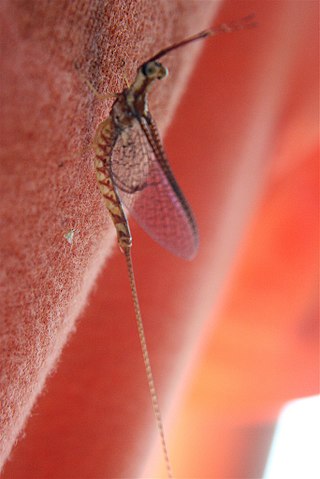
Hexagenia limbata, the giant mayfly, is a species of mayfly in the family Ephemeridae. It is native to North America where it is distributed widely near lakes and slow-moving rivers. The larvae, known as nymphs, are aquatic and burrow in mud and the adult insects have brief lives. They are often referred to as fish flies around the Great Lakes as they tend to cause the areas around water to smell like rotten fish.
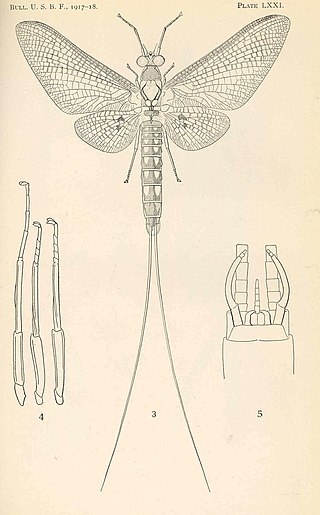
Hexagenia bilineata is a species of mayfly in the family Ephemeridae. It is native to North America where it is found in the Upper Mississippi Valley. Sometimes adults of this mayfly are so abundant as to cause a nuisance because of their enormous numbers. The larvae are aquatic and burrow in mud and the adult insects have brief lives.

Leptophlebia marginata, the sepia dun, is a species of mayfly in the family Leptophlebiidae. It is native to Europe and North America where it is distributed widely near lakes, ponds and slow-moving streams. The larvae, which are known as nymphs, are aquatic.
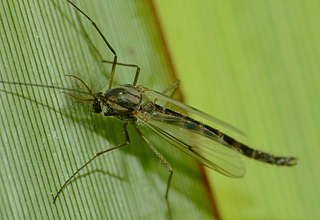
Chironomus zealandicus, commonly known as the New Zealand midge, common midge, or non-biting midge, is an insect of the Chironomidae family that is endemic to New Zealand. The worm-like larvae are known to fisherman and have a common name of blood worm due to their red color and elongated blood gills.

Ephemera simulans is a species of mayfly. It is commonly found throughout the United States. The species is used for fly fishing.
